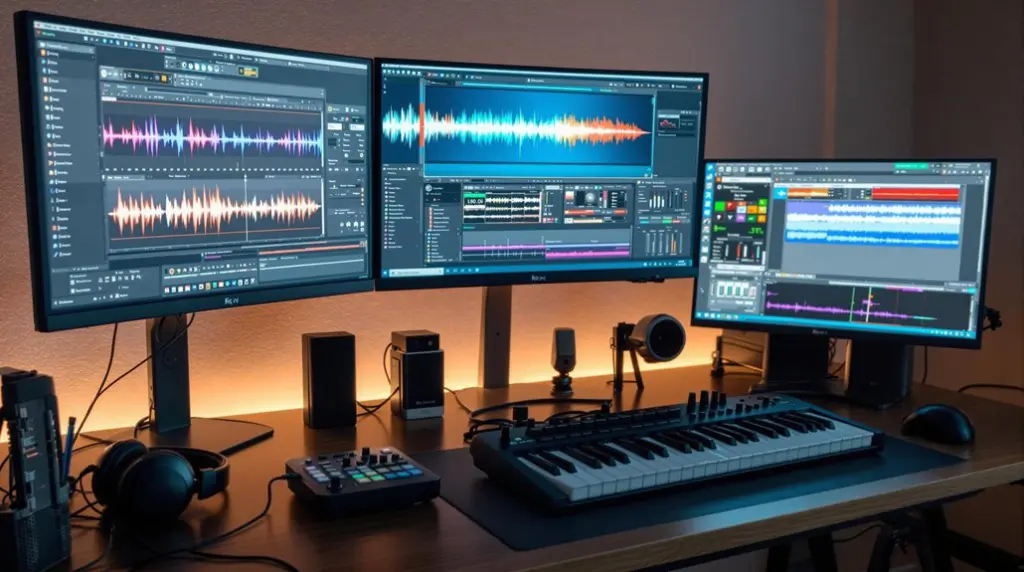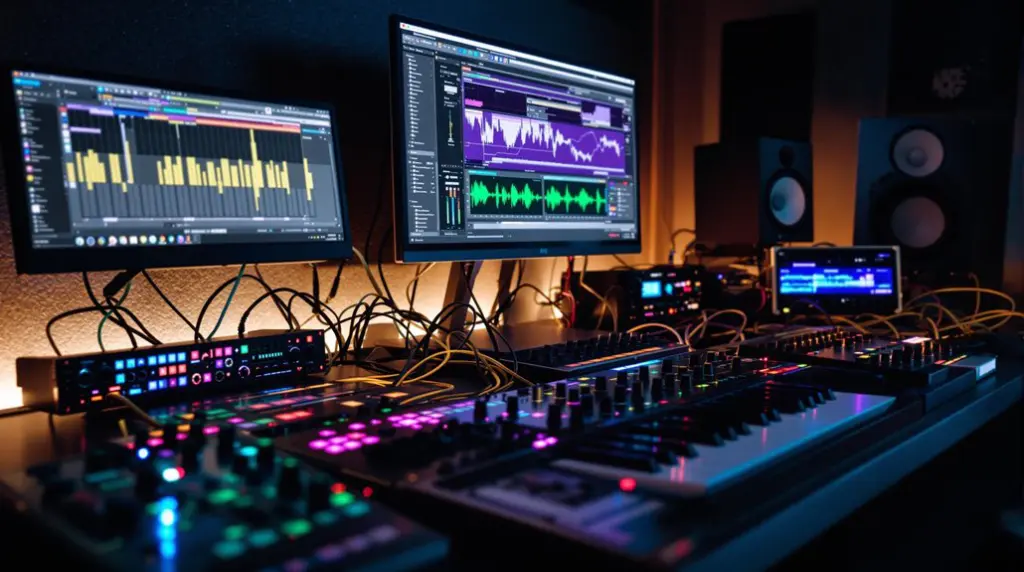The Behringer Poly D deserves your attention for its rich sound capabilities, featuring four VCOs and classic Moog-style filters that enhance tonal warmth and depth. Its versatile oscillators allow for extensive tonal exploration, while the powerful modulation options offer dynamic sound shaping. The thorough ADSR envelope controls and customizable filters enable precise sound sculpting. With a competitive price point, the Poly D provides exceptional value, boasting features typically reserved for higher-end synthesizers. Highly praised by the community for its robust build and sound fidelity, the Poly D continues to impress musicians; discover how it can raise your musical creations.
Key Takeaways
- Four VCOs provide exceptional sound richness and versatility.
- Classic Moog-style 24-dB low-pass filter delivers warm, sculpted tones.
- Built-in BBD stereo chorus effect adds spatial depth to sounds.
- Affordable price at $569 offers high value for analog synthesis.
- Positive user reviews highlight robust build quality and impressive sound fidelity.
Rich Sound Capabilities
The Behringer Poly D stands out in the crowded field of analog synthesizers due to its rich sound capabilities, largely attributed to its four Voltage Controlled Oscillators (VCOs). Each VCO offers five distinct waveforms—triangular, saw, square, and pulse—providing a diverse palette for sophisticated sound design.
This versatility allows musicians to engage in profound tonal exploration, creating everything from lush pads to sharp leads with remarkable ease. Additionally, using high-pass filters to eliminate unnecessary low frequencies can further define and clean the Poly D’s rich tones.
Praised for its thick, full, and rich analog sounds, the Poly D has been affectionately dubbed a “Mini Moog on steroids.” This moniker underscores its enhanced versatility across various musical genres. The synthesizer’s classic Moog-style 24-dB low-pass filter further improves its sound quality. This filter enables precise sculpting of tones, making it an invaluable tool for both studio production and live performance.
Additionally, the built-in BBD stereo chorus effect adds a spatial dimension to the sound, enriching the overall sonic experience without compromising the fundamental character.
With the capability to play up to four notes simultaneously in paraphonic mode, the Poly D facilitates the creation of lush chords while preserving the deep, rich quality inherent to analog synthesis.
Versatile Oscillators
The Behringer Poly D’s versatile oscillators stand out due to their wide waveform selection and multi-octave range capabilities.
Each of the four oscillators can produce five distinct waveforms, offering a broad spectrum of sonic textures.
Additionally, the ability to fine-tune and detune oscillators across multiple octaves enriches the sound, making the Poly D an exceptional tool for both intricate sound design and expansive musical compositions.
Wide Waveform Selection
A standout feature of the Behringer Poly D is its wide waveform selection, facilitated by its four versatile Voltage Controlled Oscillators (VCOs). Each of the VCOs offers a diverse array of five waveforms: triangular, saw, square, pulse, and inverted saw.
This extensive selection invites waveform creativity and sound experimentation, allowing musicians to craft unique and dynamic tones. The ability to fine-tune the first three oscillators for detuning effects further enhances the richness and complexity of the sound, evoking the lush, layered qualities of vintage analog synthesizers.
The fourth oscillator’s dual functionality adds another layer of versatility. When disconnected from the keyboard, it can operate as an independent Low-Frequency Oscillator (LFO), providing continuous modulation capabilities that do not rely on key presses. This feature is particularly useful for creating evolving soundscapes and rhythmic modulations.
Additionally, the Poly D offers precise control over waveform volume for each oscillator, enabling users to balance and shape their patches with exceptional accuracy.
The inclusion of pink and white noise generation options further expands the sonic palette, allowing for the blending of noise elements to create complex textures and depth. This thorough waveform selection underscores the Poly D’s potential for innovative sound design.
Multi-Octave Range
Exploring the multi-octave range of the Behringer Poly D reveals its immense versatility and adaptability for various musical contexts. This analog synthesizer’s four Voltage Controlled Oscillators (VCOs) offer octave flexibility that is essential for tonal exploration. Each oscillator can be adjusted across a 6-octave range, allowing musicians to craft pitches suitable for diverse genres, from bass-heavy tracks to soaring leads.
The Poly D’s VCOs can produce five distinct waveforms—triangular, saw, square, and pulse—enabling a rich variety of sound textures. In addition, the second and third oscillators feature fine-tuning capabilities, perfect for creating complex detuning effects that enhance the richness and depth of the sound. The fourth oscillator, when disconnected from the keyboard, can serve as a low-frequency oscillator (LFO), offering continuous frequency output for dynamic modulation possibilities.
Moreover, the inclusion of noise functions providing both pink and white noise options allows users to blend these textures with the oscillator outputs, thereby expanding their sound design palette.
| Feature | Description |
|---|---|
| Oscillator Count | Four VCOs |
| Octave Range | 6-octave flexibility |
| Waveforms | Triangular, saw, square, pulse |
| Additional Capabilities | Fine-tuning, LFO mode, pink and white noise functions |
This extensive feature set makes the Behringer Poly D a powerful tool for any synthesist.
Modulation Options
The Behringer Poly D offers versatile LFO capabilities, allowing musicians to shape their sound with precision through extensive waveform selection.
These options provide greater flexibility in modulating pitch, filter, and other parameters, fostering a dynamic and evolving auditory experience.
With real-time modulation and intricate envelope control, the Poly D stands out as a powerful tool for both studio production and live performance.
Versatile LFO Capabilities
Among the standout features of the Behringer Poly D is its versatile LFO (Low-Frequency Oscillator), which greatly enhances its sound design capabilities. This LFO modulation can be applied to various parameters, such as pitch and filter cutoff, allowing for an extensive range of sonic textures. Users can select from multiple LFO rates, including 32s, 16s, 8s, 4s, and 2s, providing a broad spectrum of modulation speeds to suit different musical needs.
A significant advantage of the Poly D’s LFO is its ability to sync to the tempo of a song, facilitating rhythmic enhancement that aligns perfectly with musical timing. Additionally, the fourth oscillator can be repurposed as an LFO when disconnected from the keyboard, offering constant frequency output for further modulation flexibility. This dynamic capability enables real-time modulation of parameters, creating evolving sounds that are ideal for various genres and styles.
| LFO Rate Options | Description |
|---|---|
| 32s | Slow, evolving modulations |
| 16s | Gradual, noticeable changes |
| 8s | Moderate, rhythmic influences |
| 4s & 2s | Fast, pronounced modulations |
The Poly D’s versatile LFO capabilities guarantee it remains a powerful tool for sound designers and musicians seeking to explore dynamic and intricate soundscapes.
Extensive Waveform Selection
A hallmark of the Behringer Poly D is its extensive waveform selection, providing a robust foundation for intricate sound design and modulation. The synthesizer features four Voltage Controlled Oscillators (VCOs), each offering five distinct waveforms—triangular, saw, square, narrow pulse, and tri saw. This array of waveforms enables users to explore a wide spectrum of sonic textures through waveform layering and waveform blending.
Key aspects of the Poly D’s waveform selection include:
- Detuning Effects: The second and third oscillators can be fine-tuned to create detuning effects, adding depth and richness to the sound. This capability allows for subtle pitch variations that enhance the overall sonic complexity.
- LFO Functionality: The fourth oscillator can operate as a Low-Frequency Oscillator (LFO) when disconnected from the keyboard. This feature provides a constant frequency output that can be used for independent modulation effects, offering precise control over dynamic sound shaping.
- Noise Generation: The Poly D supports both pink and white noise generation, which can be mixed with oscillator outputs. This addition broadens the textural variety, allowing for more creative sound design.
With adjustable oscillator volume management and a diverse range of LFO rates, the Poly D guarantees thorough modulation control, making it an essential tool for any sound designer.
Envelope Control
When delving into the capabilities of the Behringer Poly D, envelope control stands out as a vital feature that shapes the instrument’s sonic character. This versatile system, built around Attack, Decay, Sustain, and Release (ADSR) parameters, provides musicians with powerful tools for envelope shaping and dynamic expression.
The Attack setting is essential, as it dictates how quickly the sound reaches its peak volume. Whether one prefers smooth, gradual introductions or abrupt, striking notes, the Poly D’s Attack parameter accommodates a wide range of sonic possibilities. Following this, the Decay parameter comes into play, determining how swiftly the sound descends to its Sustain level. This control adds a layer of nuance, allowing for tailored sound evolution that can be as brief or extended as desired.
Sustain settings are equally important, maintaining the sound level while a key is pressed, which enables continuous notes or rhythmic patterns. Additionally, incorporating harmonic saturation can add warmth and character to the sound, further enhancing its depth.
Filter Manipulation
Envelope control is undeniably essential in shaping the sonic character of the Behringer Poly D, but equally significant is the domain of filter manipulation. The Poly D boasts a classic Moog-style 24-dB low-pass filter, which is instrumental in crafting its rich and warm sound. This filter excels at cutting high frequencies, thereby emphasizing the lower frequencies that contribute to its distinctive tonal warmth.
Like the Ableton Push 2, which offers high-res displays for enhanced sound design, the Poly D’s filter manipulation features provide users with precise control, making it a favorite among sound designers.
Key aspects of filter manipulation include:
- Cutoff Frequency: This parameter allows users to define which frequencies are allowed to pass through the filter, providing a powerful tool for tailoring the sound to fit various musical styles.
- Filter Resonance: By increasing the resonance, users can create peaks at the cutoff frequency, adding character and producing pronounced effects that can transform the sonic landscape of a track.
- Key Tracking: This functionality adjusts the cutoff frequency based on the played key, offering one-third and two-thirds octave options for precise filter response across different pitches.
Understanding these elements is vital for effective sound design. The interplay between cutoff frequency, filter resonance, and key tracking allows musicians to shape the Poly D’s output with precision, ensuring it stands out in any musical context.
Affordability
Affordability is a significant advantage of the Behringer Poly D, positioning it as an attractive option for both novice and experienced musicians. Priced competitively at around $569, the Poly D stands out in the analog synthesizer market, particularly when compared to higher-priced models like the Minimoog. This pricing strategy not only makes it one of the more budget friendly features available but also enhances its value proposition.
In addition, the Poly D offers essential music production tools like four VCOs and a classic ladder filter, typically found in more expensive synthesizers.
Moreover, the availability of manageable payment plans—such as $94.83 monthly over six months—broadens its accessibility, allowing a wider audience to experience its superior sound quality and functionality without a hefty upfront investment. This cost-effective approach is particularly beneficial for emerging musicians and hobbyists who seek to explore rich analog sounds without breaking the bank.
The Poly D offers a plethora of features typically found in more expensive synthesizers, including four VCOs, a classic ladder filter, and built-in effects. These elements underscore the synthesizer’s “big bang for the buck” reputation, providing impressive value that justifies its cost.
In a market where true polyphonic synthesizers at similar price points often skimp on features, the Poly D emerges as a compelling, budget-friendly choice.
Community Feedback
Beyond its competitive pricing, the Behringer Poly D also garners significant acclaim from the music community, evidenced by its impressive overall rating of 4.5 out of 5 stars. This high rating reflects widespread user satisfaction, with a notable 65% of reviews awarding it 5 stars.
Users describe the Poly D as a “Mini Moog on steroids,” applauding its rich analog sounds and versatility in both mono and paraphonic modes. To enhance the sound quality, users can employ techniques such as equalization and noise reduction to guarantee clear and professional audio output.
Key Points from Community Feedback:
- User Experiences: Many users, including beginners, report a quick and intuitive mastery of the Poly D’s features and functions, enhancing its appeal to a broad audience.
- Build Quality and Aesthetics: Community members frequently highlight the robust build quality and aesthetic appeal, contributing to the perception of the Poly D as a durable and reliable instrument.
- Sound Fidelity: Despite some critiques regarding low output levels and the absence of built-in effects, users consistently praise the synthesizer for its impressive sound fidelity and control responsiveness.
Frequently Asked Questions
What Is the Behringer Poly D Copy Of?
The Behringer Poly D is a recreation of the classic Moog Model D, incorporating analog synthesis techniques and design elements reminiscent of the iconic 1970s synthesizer, aligning it with the distinguished lineage of Behringer synths.
How Many Voices Are There in Poly D?
The Behringer Poly D synthesizer features a voice architecture with a maximum of 4 voices, allowing complex sound layering. This capability enables users to play up to 4 notes simultaneously, enhancing creative possibilities in polyphonic mode.
Is the Poly D Polyphonic?
The Behringer Poly D is not a true polyphonic synthesizer; it is paraphonic, featuring four VCOs that share envelopes and filters. This configuration offers distinct synth features for rich sound design, though individual note articulation is limited.
Which Behringer Synths Are Polyphonic?
The Behringer DeepMind series stands out with true polyphonic capabilities, offering up to 12 voices, making it ideal for advanced sound design. In contrast, the Poly D is paraphonic, supporting up to four notes simultaneously with shared synth features.
Conclusion
The Behringer Poly D synthesizer stands out due to its rich sound capabilities, versatile oscillators, extensive modulation options, precise envelope control, and effective filter manipulation. Coupled with its affordability, the Poly D offers substantial value, making it an attractive option for both novice and experienced musicians. Community feedback further underscores its reliability and performance. Overall, the Behringer Poly D merits attention for its thorough features and cost-effective pricing.




